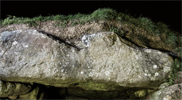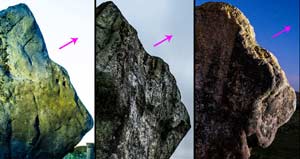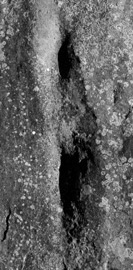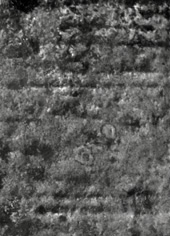|
Aubrey Burl And His Denial Of The Neolithic Faces In The
Avebury Stones

Dr Burl wrote a well-known text on Avebury called
“Prehistoric Avebury”. The book admittedly enjoys a good
reputation, and as it is easy to find on Amazon I imagine that lots of readers
new to Avebury studies read him first.
Accordingly, his views on the existence of the Avebury carvings are
likely to be highly influential, but I believe that on the question of the Avebury statues he is unsound.
What concerns me about Dr Burl’s writing about the faces isn’t
that he supports a conclusion that I disagree with, what concerns me is that he
doesn’t consider both sides of the question in reaching it.
He could easily
have reproduced and discussed photographs of alleged carved faces, and
explained exactly why he considers each was only a chance of nature and not a work of art. He doesn’t even accept that the stones contain
deliberately selected simulacra, it’s as if he thinks the stones are no more than Neolithic traffic
bollards, markers chosen merely because they were big enough.
I am struck by how relatively few illustrations or photographs there are in Dr Burl's book. It is as if Dr Burl is generally less interested in the visual than the textual, which might prove a disability when considering the faces, which at least initially often require quite a good eye, particularly when the carvings are not viewed at the time of day or season they were intended to be visible.
Allow me to pick out some points from Dr Burl's text for discussion:
Page 215 Line 3:
“The naturally corroded shapes of (other)
stones at Avebury have been visualised as lions, horses, oxen, a bison, an
imaginative megalithic menagerie.”
No one supporting the existence of the stone carvings at
Avebury would say that it is always easy to say exactly what kind of face/aminal/spirit
they are regarding. If I saw an Avebury
carving as a young deer, and another viewer interpreted the same artifact as a calf, that doesn’t mean there is no carving at all – there is no
imagination or fantasy involved, just a natural ambiguity in the carving because sarsen
can only be chiselled with so much precision.
Here is a link to an image of the deer/calf carving by the way:

Page 215 Line 4:
“It is very tempting with a poetically
searching eye to recognise the shapes of animals, a mother and child, a human
head created by the distortions of nature”
a) He cannot just deal with the issue by dismissing photographs of the faces (which of course he does not consider at all in his book) by smearing the topic as "poetic". This is a mere debating device, not archaeology.
b) Furthermore
if the faces can be shown to display consistent patterns (and the Avebury
carvings do so to a surprising degree) then surely they must be actually
artificial not romantic fantasy. I have prepared more than one page detailing specific families of Avebury carvings that are certainly based on a clear and consistent artistic design, adapted to different locations and stone sizes - click here and here to see two such pages.
c) Dr Burl denies the existence of animal and human faces
carved into the sarsens, below are 5 thumbnail links to examples at Avebury that quckly and easily prove him wrong.
In incredibly strong male face on Stone 15a:

Also a clear image of a hare inscribed on Cove Stone II:

Also a clearly defined bull’s head in the main Henge:

Also a sensitively carved left profiled face in the West Kennet Avenue:

And a boldly styled face, also from the West Kennet Avenue:

There are many other examples I could have chosen, but as well as individual faces at Avebury there are repeated monumental depictions of the same gigantic block face at the largest possible scales. The profile on Stone 98 is particularly impressive as it takes up the entire massive monolith, and represents a triumph of sculpture, enormous yet subtle at the same time:

Page 215 Line 15
“Even more remarkably “of the undamaged
megaliths inside Avebury Henge which bear recognisable heads (which means the
majority of them) left-facing heads number 50 against nine right-facing ones”.
Sinister”
Although I cannot find a reference on page 215 to the
research Dr Burl refers to here, I know from my own reading that he is in
fact quoting Professor Meaden’s Secrets book page 7. I think it is quite poor manners for Dr Burl not to
properly analyse the validity of another academic’s work which he has chosen to
quote and then ridicule it with a poor pun on the latin word for left
(sinister). As we will see this will
not be the only time that Dr Burl’s sense of humour will lead him astray on
this topic.
It is in fact a pity that Dr Burl didn’t read on and
quote something else that Professor Meaden said on his page 7 because it holds
the key to understanding the entire topic, The professor explains “They are likely to be heads which the Neolithic
worshippers knew too, and that is the ultimate criterion." Dr
Burl never takes this crucial point, if we, with the same visual cortexes our
predecessors possessed, interpret the stones as having faces, then in terms of
understanding the Neolithic mind they necessarily existed for them too.
Page 215 Final Line:
"The 'minimal sculptures' are surely coincidental"
Why "surely" - why does he not go on to demonstrate why it is so obvious the stones have no intended form? From the tone of his writing you would think he would find it easy to do so, but he fails to flesh out an argument.
On the other hand, believers in the existence of the faces can easily point to tool marks on the faces which prove these are artificial, for example the chisel pecking marks here on Stone 26a, or clear hammer marks on Stone 26b here.
Page 215 Final Line And Page 216 Line 1:
"Equally optimistic, even jocular interpretations have been made elsewhere of natural configurations"
Believers in the faces are reduced here to being merely "optimistic" or "jocular" as if we are just fun loving chappies - this is just a debating tactic, not an argument. He then gives the example of Long Meg being erroneously described by some as having breasts. I know nothing of Long Meg or whether she has carved breasts, but here at Avebury the prominent Stone 45 of the West Kennet Long Barrow certainly displays a carved vagina which isn't so very different thematically:

This isn't optimism or jocularity, it's a reverential depiction of mother nature's creative force, especially appropriate as the West Kennet Long Barrow was the early center of Avebury's rebirth religion. The Neolithics were not sniggering schoolboys, and neither are modern believers in the Avebury carvings. He goes on to imply that carving believers are akin to fantasists who believe stories about wars between men and eagles. This is mere "straw man" informal logic with no attempt at balance, nearly as unconvincing as the jokes.
Page 216 Line 12:
Dr Burl states that belief in the faces is the product of a sincere but misguided "seek and you shall find" mentality. Again as so often, this isn't an argument, it's a slogan or tactic. I could equally speciously reply "There are none so blind as those who will not see". Neither of us having advanced the argument in any positive way whatsoever by the way.
Page 216 Line 13:
"Given the almost intractable nature of
sarsen and the fact that the majority of large blocks had been at least
half-buried when men came for them it is difficult to believe that the boulders
were specifically chosen for their human likenesses. The features
were very probably fortuitous. Even the writer has observed some
similarities, often after a glass or two of Wadworth's 6X."
a) Dr Burl's contention that sarsen is too intractable basically boils down to his belief that carving it would be too hard work! This is patently an indefensible view as I shall demonstrate, but I have read it repeated elsewhere as if it were clearly true. In detail:
(i) It's worth pointing out that the culture that created Avebury was quite willing to drag 25 ton
megaliths many kilometers from the West Woods of Marlborough to Stonehenge
(according to Nash et al in Science Advances 29/07/2020 Vol 6, no.31) or to
pile up 35 million basket loads of rubble to create Silbury Hill here at
Avebury (Burl p173). Whatever else we might criticise the
Neolithic farmers for being, we cannot claim that they were workshy. Compared
to the unimaginable physical effort the construction of Stonehenge and Silbury required, the labour
needed to carve statues in situ at Avebury would seem relatively trivial,
frankly, particularly as the sculptors would have had many hundreds of years to do so.
(ii) Surely Dr Burl would not deny that the neighbouring and contemporaneous culture that was building Stonehenge found that sarsen could be hammered into rectangular blocks complete with woodworking type joints. To quote the official English Heritage website "To fit the upright stones with the horizontal lintels, mortice holes and
protruding tenons were created. The lintels were slotted together using
tongue and groove joints. These types of joint are usually found only
in woodworking." If sarsen were indeed intractable then Stonehenge would have been impossible - does Dr Burl believe that Stonehenge only exists in the minds of the poetic or over imaginative?
(iii) Bronze age people certainly managed to carve "115 possible or certain
axe-head carvings and three dagger carvings" into the Stonehenge stones
(Stonehenge Laser Scan: Archaeological Analysis Report, English Heritage
Project 6457, 2012 p53) This totally destroys the claim that sarsen is too hard
to carve with artistic motifs, and suggests that similar work would have been completely feasible at
Avebury a thousand years earlier.
(iv) If Dr Burl's contention that sarsen is too intractable to work then the existing Avebury stones must be in their original, natural shapes. However archaeological luminaries Keillor and (Professor) Piggott were able to state, as early as 1936 (Antiquity, Vol. 10, p420) that, "There can be no question that the stones were dressed to conform to certain shapes, and to this end were selected as near to the required form as possible." To spell this out, you can't dress intractable objects - therefore the fact that the Avebury stones were dressed proves it was not too intractable to work them in neolithic times.
The Intractability "argument" is therefore utterly without merit. Total fail.
b) The fact that the stones
were originally found half hidden in the ground of course does not prevent the
visible, upper sides being checked for simulacra or suitability for carving.
Once a stone was so selected it was dragged into final position at
Avebury, and erected. From that point on its previously invisible
side became easily available for inspection and carving.
|
If you visit Avebury yourself you can see clear evidence for this process on Stone 29a, West Kennet Avenue, where the previously hidden,
earth bound side of the monolith can be identified by clear linear drag marks
on the east facing side of the monolith (you don't flip a heavy stone before you drag it) - see image to right. This hitherto concealed
underside was then carved with a left lookng face after the stone's erection (linked to here). The juxtaposition of the carved animal face
next to the drag marks proves that the work of selecting, moving and then carving the sarsen was done in this order. It is therefore crystal clear that (i) the appearance of this originally hidden face of the stone could
have played no part in our neolithic predecessors decision to harvest this particular sarsen
over others, and (ii) therefore that Dr Burl's guess that half-buried stones can't display carvings is not valid.
|
 |
c) Dr Burl's “joke”
that you need alcoholic assistance to see the faces in the stones "after a glass or two of Wadworth's 6X" is facetious and cannot be described as a balanced, considered academic position.
d) Of course Dr Burl cannot be crticised for not refering to works published after his own, but it is to be hoped that future textbooks on Avebury will not only include details of Professor Meaden's work, but also Di Patterson's exhaustively complete guide to how the artworks were actually created. The cumulative effect of these two writer's research is undeniable and should be widely appreciated. I flatter myself that my own images of Avebury also show ample evidence of the carvings' existence.
Finally
Thousands of ordinary visitors to Avebury can see the Neolithic faces on the stones, and large numbers of these artifacts were clearly documented in Professor Meaden's 1999 Secrets book, a book issued long enough before the 2002 second edition of Dr Birl's book. Why then is Dr Burl unwilling to examine the question in a balanced, objective way? - why does he feel the need to decorate his denials with jokes, or use dog-whistle debating tactics? Its almost as if Dr Burl expected future generations of archaelogists to automatically ignore the issue of whether the carvings exist or not just because he said so. His position appears dogmatic, not evidential.
To me visiting Avebury armed only with a copy of Dr Burl's “Prehistoric Avebury" is like visiting the Uffizi wearing a blindfold. His briefly expressed dogma that there are no artworks here should not be mindlessly parroted by future generations of archaeologists merely out of fear of looking romantic or flaky, instead I am sure a more confident, enlightened and empirical approach will triumph, particularly when the 3D laser scanners arrive at Avebury to analyse the shapes and contours of the stones in proper detail, a process that I understand is underway at Stonehenge. To end this critique on a constructive note I quote from page 10 of Di Pattison's book:
|
"At their simplest these carvings are far removed from casual scratchings. At its best the work evidences careful consideration of formal, aesthetic and scientific elements such as colour, scale, line, composition, proportion, close observations of human and animal anatomy and the application of geometry to design. Were there no toolmarks, the repeated evidence of these thought processes might be sufficient to distinguish a body of carefully made artifacts from a collection of chance resemblances. Art-loving readers will immediately identify with the cognitive aspects. The artists were surely giving of their best efforts to enhance the stones and architectural structures, not vandalising what their ancestors and contemporaries had worked so hard to build. Both the stonemasonry and the carving were integral aspects of the whole from the outset, not afterthoughts, and this can be repeatedly demonstrated.
Avebury's and West Kennet's is, in a sense, such exciting and 'contemporary' artwork: it is conceptual; loaded with visual metaphor; landscape-related landart; interactive; three and four dimensional; responsive to the extraordinary qualities within the natural stone. Arguably, until recent times, most people (including archaeologists who were not art lovers or art historians) would have been unfamiliar with this kind of artwork anyway. One must approach the examination of the stones with an informed and contemplative mind, not an over-imaginative mind, and not a closed one."
|
|